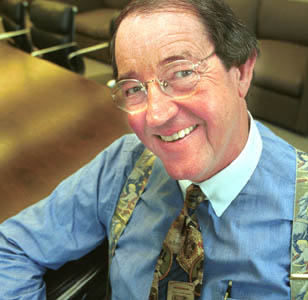![[Metroactive News&Issues]](http://metroactive.com/gifs/news468.gif)
[ San Jose | Metroactive Central | Archives ]
Easy For You to Say: Santa Clara County Tax Assessor Larry Stone says the notion that stutterers are withdrawn and unwilling to speak is a myth. He says he loves public speaking and frequently has a chance to do so in his career.
Speak Uneasy
Despite decades of research and a host of new therapies, the cure for America's 3 million stutterers remains unknown
By Sam Boykin
MY HEART WENT OUT to the guy on the phone. I was interviewing a local business owner and as soon as he started talking, I recognized all the signs and coping mechanisms of someone who stuttered. There was the slow, studied cadence, the deliberate, practiced manner of pronunciation, the insertion of multiple "um's" in his sentences and his tendency to stretch out the first syllable of a certain word as he struggled to make his mind and mouth work in unison.
I could sympathize with every verbal stumble, false start and compensatory trick because it loosely resembled the way I used to talk. Between the ages of 10 and 16 I struggled with what most people take for granted--just open your mouth and the words come out, right? For about 3 million Americans it's not nearly that simple. And as an already awkward, gangly teenager with pimples, it didn't exactly help that I had trouble putting words together.
I'm lucky, though; for the most part I've outgrown the problem, at least to where it's now manageable. But to this day I can still be in mid-sentence, rolling along just fine, and suddenly I know there's no way the next word my brain is sending down to my mouth is going to make it out in one piece. I'm forced to instantaneously come up with an alternate word my mouth is more willing to cooperate with, or, like my interviewee, interject multiple "um's" until my mouth decides to kick into gear again. As a reporter--where word economy and fluency are integral parts of the job, particularly during interviews, having to rely on these kinds of verbal gymnastics can be a real pain--and embarrassment.
For many, stuttering is much more than just an adolescent inconvenience. It's a lifelong ordeal and an impediment, both socially and professionally, that can be devastating. While most people are afraid to speak in front of a large crowd, think about having that same fear as it relates to everyday, normal conversations. Imagine being someone who stutters during a job interview; when you're out on a date; when you're called on in class; or just during a simple exchange with a stranger while waiting in line at the bank--all normal, everyday situations, yet all potentially humiliating to someone who stutters.
You always hear about how much we communicate through body language, but our vocal skills are the real thing--an integral part of who we are, how we express ourselves and how we're perceived. Because speech is such a fundamental form of communication, being unable to do it fluidly can be extremely disabling, which of course is made worse by the many stigmas and prejudices associated with stuttering. People who stutter are often perceived as slow or socially inept, and characters like Howard Stern's Stuttering John and cartoon character Porky Pig only perpetuate the buffoonish, comical stereotypes.
While there's no miracle cure for stuttering, research has yielded a great deal of new information, and therapy has come a long way in the past few decades in helping remedy what is still a largely misunderstood problem.
It's All in Your Head
PERHAPS THE MOST widely recognized authority on stuttering and stuttering therapy is the Stuttering Foundation of America, based in Memphis, Tenn. Malcolm Fraser, who struggled with the disability all his life, founded the organization in 1947 with the goal of providing information about the prevention of stuttering in young children and the treatments available for teenagers and adults.
Since then a great deal of research has been conducted, most recently exploring brain waves and genetics as possible causes, which has resulted in many progressive new therapy techniques. Despite decades of research, the causes of stuttering are still largely unknown. It is known, however, that over 3 million Americans stutter and that it affects four times as many males as females.
While there are some clinics that claim they can "cure" anyone of stuttering, their techniques usually involve spending an extended period of time in a controlled environment where intensive therapy takes place. The therapists interviewed for this story agree that such methods are usually ineffective because the therapy is taking place in a clinical environment, and eventually the patient has to return home to his or her regular routine, where the same problems inevitably reoccur.
Most seem to agree that therapy is more about controlling and improving--not curing--fluency problems. Of course, a key to finding the best method to reach that goal is to have a more definitive answer about the causes. While most therapists think researchers are narrowing the causes down, there are dozens of theories, as well as the age-old debate of whether it's nature or nurture.
"I believe it's some of both," and Jeri Bates, vice president and chief operating officer of Speechcenter Inc. "Stuttering, while it doesn't have a totally physiological ideology, does have components of breathing, environment, stress and anxiety."
Hide Tech: Lisa K. Breakey, a speech pathologist who works with stutterers, says she encounters many clients who have chosen high-tech work--as engineers--because the job doesn't require lots of verbal communication.
Treatment and Therapy
MOST FOLKS probably associate Porky Pig's "th-th-th-that's all folks" trademark line with typical stuttering. Not to get too technical, but in speech pathology that's known as "blocking," where the air flow gets blocked and there's a repetition of the sound.
Another common form of stuttering is known as "closis." This involves the speaker getting stuck on sounds like "p, b, m," which are spoken with the lips closed and teeth open.
Actually, unless the case is particularly severe, what most people hear when talking to someone who stutters are the techniques they've developed so they won't make those repetitive or blocked sounds.
When a stuttering problem persists past adolescence and into adulthood it usually becomes far more difficult to control. Therapists say this has to do with both learned behavior and people's general attitude about stuttering and therapy.
"People just don't know where to turn," said Bates. "They're humiliated and very self-conscious and they just kind of give up. They've had it. There are a lot of people out there in their mid-30s and 40s who sort of got lost. They should be at the height of their profession, but they're really struggling."
San Jose speech pathologist Lisa Breakey often encounters patients that have chosen careers because of their speech difficulties.
"What's interesting is a lot of men come to me who are engineers," says Breakey. "They went into it because of their [problems with] communication skills, but it wasn't what they wanted to do. They're also getting older and want to get in management positions," adds Breakey. "That requires communication skills."
Santa Clara County County Tax Assessor Larry Stone would disagree. A high-profile public official, Stone is also a popular public speaker, even though he has battled with a stuttering problem since childhood.
"Personally, I enjoy public speaking," says Stone. "This whole idea of the introverted stutterer, because he doesn't like to talk, I just don't see much of this. In fact, I think it's the opposite."
Stone wonders if being success-driven is one of the characteristics of stutterers, and names some of the many luminaries who have stuttered: Dustin Hoffman, Bobby Kennedy, Jack Paar and Jimmy Stewart, for example.
"It's like climbing a mountain," says Stone of the effort to push past his speech disorder. "It's hard, but that's why you do it."
There are numerous therapy approaches practiced today, many of them focusing on the patient slowing down his or her rate of speech, decreasing the tension and speaking in a more continuous phonation. There's even a new therapy technique based on biofeedback. Resembling a hearing aid, a device worn in the ear changes how the speaker perceives his/her own voice, and the user can usually tell within a matter of hours if it will be effective.
Perhaps the most common therapy is having the patient develop what is known as "secondary compensatory techniques." Usually individuals who stutter develop these verbal or physical techniques naturally, such as the "um, um, um" you may hear some people say while they're speaking. These individuals don't necessarily have a limited vocabulary or a word retrieval problem; it's simply their way of buying themselves some time so they can effectively manage their stutter.
"People often create secondary behaviors like tapping their toe," Bates said. "And that works great for a while. But then they realize they have to tap their foot. And before long they have to shake their whole leg and jump up and down to make that continue as an effective secondary measure. Eventually you're almost unrecognizable as the person you could be. You practice compensatory techniques and avoidance behavior so much that you're not really your true self. And there's so much that can be done. People have to be really careful and seek the guidance of a professional to come up with a secondary characteristic that works for them."
It's important to note that a certain amount of stuttering, or "disfluency," as it's known in the industry, is normal for kids between the ages of 2 and 4. For most children it's simply the stage of development when their language and vocabulary are advancing more than their articulation. It's estimated that about 25 percent of all children go through a stage of development during which they encounter disfluencies severe enough to concern their parents.
Speech therapists stress that how parents react during this stage is critical and can have a great influence on how the situation turns out.
Bates warns parents not to overreact or fixate on the problem. "What can happen is if you have a particularly anxious parent, they obsess over it. And the child is the first person to pick up on that. It then becomes a self-fulfilling prophecy. The child becomes anxious, stressed, self-conscious, and you can get a stutterer for life."
Stone knows about this firsthand. One of his sons stuttered when he was very young, but Stone took a page from his own childhood experience in how he dealt with the stutter, which his son soon outgrew.
"When someone calls attention to [a stutter], that's the worst thing," says Stone. "The best thing to do if you're a listener is to ignore it.
"And," he adds, "pay attention to the speaker."
[ San Jose | Metroactive Central | Archives ]
Copyright © 2001 Metro Publishing Inc. Metroactive is affiliated with the Boulevards Network.
For more information about the San Jose/Silicon Valley area, visit sanjose.com.
![]()

Photograph by George Sakkestad

Photograph by George Sakkestad
Kelly Luker contributed to this report.
From the January 11-17, 2001 issue of Metro, Silicon Valley's Weekly Newspaper.